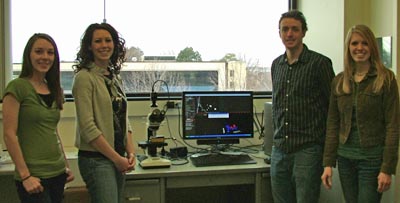Home > Press > Brigham Young University selects NanoSight to support research in the synthesis of inorganic nanoparticles
 |
| The NanoSight users at Brigham Young University |
Abstract:
The Department of Chemistry & Biochemistry at Brigham Young University (BYU) has chosen the NanoSight LM-10 system to support their research into the synthesis of inorganic nanoparticles, principally metal oxides.
Brigham Young University selects NanoSight to support research in the synthesis of inorganic nanoparticles
Salisbury, UK | Posted on January 26th, 2010The BYU research team of Dr. Brian Woodfield are working on the development of an elegantly simple process that allows the group to make a nearly unlimited array of well-defined inorganic nanoparticles that have controlled sizes from 1 nm to bulk. The particles are highly crystalline with well defined shapes (usually spherical but also rods). The method produces them with chemical and phase purities as high as 99.9999% while the particle size distribution is controlled to approximately ±10%. Dr. Woodfield projects with confidence that they can make industrial size quantities with manufacturing costs significantly less than any other current technique.
Principal user is PhD candidate Betsy Olsen. She has been very impressed with the instrument. "The NanoSight is used to measure particle size as one way to quantify the amount of agglomeration in the process and to see if our de-agglomeration/dispersion techniques are working."
Olsen continued, "The system is used along side other techniques such as TEM and DLS. However, The NanoSight is much faster, less expensive and easier to run than TEM. It provides more control compared to DLS and other traditional particle size analyzers as it allows you to visualize what you are measuring particle by particle. For example, this means you can follow a polydispersed system more accurately."
NanoSight's approach, known as Nanoparticle Tracking Analysis (NTA), has been shown to be ideally suited to both research and process control use. The system is an extremely powerful nanoscale research and development tool for looking a broad range of particle types and concentrations.
To learn more about nanoparticle characterisation using NTA, please visit the company's website (www.nanosight.com) and register for the latest issue of NanoTrail, the company's electronic newsletter.
####
About NanoSight
NanoSight Ltd, of Salisbury, UK, is the world leading provider of instruments for the optical detection and real time analysis of sub-micron particles. The Company supplies unique instruments for nanoparticle analysis in the sub-micron region that go far beyond existing light scattering techniques in the characterisation of polydispersed systems. NanoSight delivers direct visualisation of individual nanoscale particles in suspension from which independent quantitative estimation of particle size, size distribution and concentration are immediately obtained. In viral titre assessment, NanoSight produces more accurate concentration results than plaque assay, and delivers them within minutes, validating the results with a unique real-time image. Founded in 2004, the company currently has more than 200 systems in service worldwide, having begun commercial sales in 2006.
The Company has a growing base of users worldwide, including BASF, BP GlaxoSmithKline, Novartis, 3M Corp, Roche, Solvay & Unilever and many universities.
For more information, please click here
Contacts:
NanoSight Limited
Minton Park
London Road
Amesbury SP4 7RT
T +44 (0) 1980 676060
F +44 (0) 1980 624703
NetDyaLog Limited
39 de Bohun Court
Saffron Walden
Essex CB10 2BA
T +44 (0) 1799 521881
M +44 (0) 7843 012997
Copyright © NanoSight
If you have a comment, please Contact us.Issuers of news releases, not 7th Wave, Inc. or Nanotechnology Now, are solely responsible for the accuracy of the content.
| Related News Press |
News and information
![]() Researchers develop molecular qubits that communicate at telecom frequencies October 3rd, 2025
Researchers develop molecular qubits that communicate at telecom frequencies October 3rd, 2025
![]() Next-generation quantum communication October 3rd, 2025
Next-generation quantum communication October 3rd, 2025
![]() "Nanoreactor" cage uses visible light for catalytic and ultra-selective cross-cycloadditions October 3rd, 2025
"Nanoreactor" cage uses visible light for catalytic and ultra-selective cross-cycloadditions October 3rd, 2025
Academic/Education
![]() Rice University launches Rice Synthetic Biology Institute to improve lives January 12th, 2024
Rice University launches Rice Synthetic Biology Institute to improve lives January 12th, 2024
![]() Multi-institution, $4.6 million NSF grant to fund nanotechnology training September 9th, 2022
Multi-institution, $4.6 million NSF grant to fund nanotechnology training September 9th, 2022
Announcements
![]() Rice membrane extracts lithium from brines with greater speed, less waste October 3rd, 2025
Rice membrane extracts lithium from brines with greater speed, less waste October 3rd, 2025
![]() Researchers develop molecular qubits that communicate at telecom frequencies October 3rd, 2025
Researchers develop molecular qubits that communicate at telecom frequencies October 3rd, 2025
![]() Next-generation quantum communication October 3rd, 2025
Next-generation quantum communication October 3rd, 2025
![]() "Nanoreactor" cage uses visible light for catalytic and ultra-selective cross-cycloadditions October 3rd, 2025
"Nanoreactor" cage uses visible light for catalytic and ultra-selective cross-cycloadditions October 3rd, 2025
Tools
![]() Japan launches fully domestically produced quantum computer: Expo visitors to experience quantum computing firsthand August 8th, 2025
Japan launches fully domestically produced quantum computer: Expo visitors to experience quantum computing firsthand August 8th, 2025
![]() Rice researchers harness gravity to create low-cost device for rapid cell analysis February 28th, 2025
Rice researchers harness gravity to create low-cost device for rapid cell analysis February 28th, 2025
|
|
||
|
|
||
| The latest news from around the world, FREE | ||
|
|
||
|
|
||
| Premium Products | ||
|
|
||
|
Only the news you want to read!
Learn More |
||
|
|
||
|
Full-service, expert consulting
Learn More |
||
|
|
||








